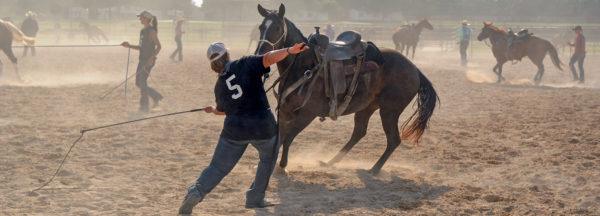November NWC Preview: Colt Starting Clinic Diary Day 3


November NWC Preview: Colt Starting Clinic Diary Day 3
Clinton Anderson from Downunder Horsemanship has spent the past 20 years creating the best training tools and videos available to help tackle some of the most challenging situations with problem horses, and with problem owners. This week, we get a chance to observe day three of Clinton’s Colts Starting Clinic in Texas.
Day three of the Colts Starting Clinic began with a review of what had happened with the participants the day before—the first saddling of the colts used in the clinic. This was a big milestone in the transition from basic, fundamental training to colt starting specific exercises. Clinton reminds us that regardless of if a horse goes off violently with the saddle and bucks around the round pen, chases you, or walks off like an angel, it means nothing. As long as you stay on top of it and work towards making progress to avoid habit formation, you’ll be fine. However, repeated behavior with horses can become habits pretty quickly, which is why they begin day three by preparing the colts well enough so that they don’t buck with the saddle.
To ensure that your colt isn’t going to buck, you need to make sure you have control over him. While it’s a manageable habit, you don’t want your horse coming out every day thinking they just get to blow-off steam. Instead, Clinton wants the horses to come out with a workman’s kind of mentality. To do this, it’s important that colts know it’s their job to behave. You can communicate this with them by making sure that you don’t over feed them and under work them. You have to put in work consistently and when you do this, you’re going to get along.
Even if they seem to resettle one day, don’t trust that they will the next. Colts need to go through enough training where their behavior becomes a habit, and they fully respect their rider. Clinton tells everyone that to get to this point, you need to add a little more to their training every day. Today, he demonstrates how to use the hackamore properly and get a colt to flex. Then they’ll work on desensitizing the horses to the flapping of the stirrup and continue to add on different exercises every day. Clinton also reminds his group that when things go wrong, it can create complete chaos in the training arena and on the trail, which is why it’s important to stick to the plan and never let your guard down.
The hackamore has a different feel to the horses than the halter, so you need to make sure that you get your horse to flex really well with it. This means you need to be a little pickier about your exercises and ask a little more out of your horse. You don’t have to leave your colt saddled for 12 hours or anything, but they should be comfortable enough that they can move and worked hard enough that they behave. Some of the exercises that Clinton introduces on day three with the hackamore help to desensitize the colts to you up above their eyeline.
Clinton advises his participants to get their halter and lead rope and stickling string then go to their saddles on the fence, hang the hackamore over the saddle horn, and grab their colts. Once everyone is gathered in the outdoor arena with their colts, Jeff got them busy reviewing groundwork exercises. After the class gets their horses moving their feet and using the thinking side of their brains, they introduced the helicopter exercise to them using a participant’s horse as an example. The goal of the exercise is to be able to swing the stick and string up and over the horse’s body with high energy so that it makes a loud noise while the horse stands completely still and relaxed. They demonstrate how to perform the helicopter motion and let everyone know that this is a good way to help practice desensitizing a horse to objects above their eye level, which tend to make most horses nervous. Eventually, you’ll be sitting up on your horse’s back and you want him to be comfortable with noise and movement above him. So, the helicopter exercise is a really good exercise to help prepare them for the movement and noise that occurs when you go to ride them.
Start your digital training experience with Clinton Anderson today. Visit our website and download the Down Under Horsemanship app to experience the method in a whole new way.
Want To Learn More? SIGN UP FOR OUR LOYALTY PROGRAM
Master your horsemanship training through Clinton’s step-by-step method videos by joining the No Worries Club today. Becoming a club member ensures you get VIP pricing on all of Clinton’s must-have training tools and resources. Plus, you’ll enjoy all the phenomenal benefits that come with club membership!


